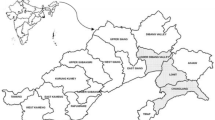Abstract
Integration of remote sensing data with other spatial/non-spatial data was carried out using ARC/INFO software package. A simple classification technique was adopted for land cover/land-use change analyses in relation to elevation, slope, aspect and bio-climatic classes. Suitability assessment of land where agricultural extension occurred between 1963 and 1993 was made using GIS software package. Expansion of agriculture and was found to be maximum in 2200-2400 m elevation zone and 20–30° slope classes. When topographic aspects were considered expansion was maximum on south east and west facing slopes. The loss of vegetal cover is estimated to be 15 per cent between 1963–1993. However regeneration of forest was found to be maximum in elevation ranges of 1600–2000 metre and mostly having 20–30° average slope, Land deterioration over the two mapping periods was identified and strategies were suggested to mitigate the problem.
Similar content being viewed by others
References
Anonymous (1983). Mapping of Forest Cover in India from Satellite Imagery. Summary Report, National Remote Sensing Agency (NRSA), Hyderabad, India.
Anonymous (1989). The State of the Forest Report 1989. Forest Survey of India (FSI), Dehradun, India.
Anonymous (1992). Marcro-level Urban Information System — A GIS case study for BMR. SAC/ISRO, BMRDA. Project Report No. SAC/RSA/NRISURIS/PR-18/MARCH 1992.
Dhinwa P S, Pathan S K, Sastry S V C, Rao M, Majumbder K L, Chotani M L, Singh J P, and Sinha R L P (1992). Land Use Change Analysis of Bharatpur District using GIS. Photonirvachak: J. Indian Soc. Remote Sensing, 20(4):237–250.
Kimoti M M and Juyal N (1996). Environmental Impact Assessment of a few selected watersheds of the Chamoli District (Central Himalaya) using Remotely Sensed Data. Int. J. Remote Sensing, 17(9):1391–1405.
Saxena K G, Kothyari B P and Rao K S (1991). Remote Sensing for Management of Biological Resources: A rational outlook for the Himalaya. In: Mountain Resources Management and Remote Sensing (Eds., P.N. Gupta & A.K. Roy). Surya Publ., Dehradun.
Saxena K G, Rao K S, Pandey A, Rana U, Sen K K, Nehal and Majila B S (1994). Sustainable Rural Development: Opportunities and Constraints (A micro-level analysis of Pranmati Watershed in Uttar Pradesh Himalaya). Himvikas Publ. No. 6. GBPIHED, Kosi, Almora.
Singh A (1991). Mapping and Monitoring of Forest Vegetation using Satellite Data: The Indian Experience. In: Environmental Monitoring: Application of Remote Sensing and GIS (ED. R.B. Singh). Geocarto International Centre, Hong Kong, pp. 151–167.
Singh Jasbir (1990). Dynamics of Agricultural Change. Oxford & IBH Publ., New Delhi.
Turner II B L (1995). Linking the Natural and Social Sciences. The Land Use/Cover Change Core Project of the IGBP. IGBP Newsletter, No. 22.
Author information
Authors and Affiliations
About this article
Cite this article
Ghosh, S., Sen, K.K., Rana, U. et al. Application of GIS for land-use/land-cover change analysis in a mountainous terrain. J Indian Soc Remote Sens 24, 193–202 (1996). https://doi.org/10.1007/BF03007332
Received:
Revised:
Issue Date:
DOI: https://doi.org/10.1007/BF03007332




